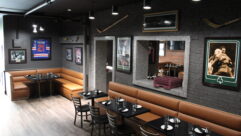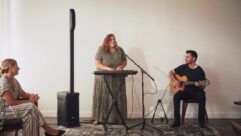Product Review: TC Electronic M-One XL
Feb 1, 2004 12:00 PM,
By John McJunkin
It’s been nearly ten years since I met John Rishoej from TC Electronic of Denmark, and I’ve followed the development of the company’s products ever since. The company’s 2290, the landmark digital delay from days of yore, is still highly prized and sought. The M5000 digital signal-processing box was a landmark product that ushered in a new age of competition between reverb manufacturers that has resulted in absolutely incredible systems. One major accomplishment of TC Electronic has been the development of affordable high-quality products. The M-One XL exemplifies that concept. It is a reverb with a level of quality that rivals competitors that cost much more. Let’s dig into the features and find out how it sounds.
CONNECTIONS AND CONTROLS
One truly astonishing feature of the M-One, considering its price, is digital I/O. I’m not aware of any other product in this price range that offers it. Specifically, it is a S/PDIF coaxial connection, available even on the M-One standard unit and certainly on the more sophisticated XL unit. I test-drove the XL, which also includes balanced XLR inputs and outputs. MIDI in, out, and thru connections are present, as well. A footpedal connection jack enables the bypass of the unit or tempo entry via tapping.
Front-panel controls are reasonably straightforward on this unit. It has knobs for input level, mix, and effect balance, which determines the balance between the two effects engines. A Routing key determines how signal is routed through the two engines. The I/O setup key determines the I/O configuration, and a Tap key sets delay times. The Utility key grants access to MIDI, SysEx ID, routing lock, Bypass mode, pedal function, and display view angle controls. The Algo|Edit 1 and 2 keys access the edit display and the ability to change the parameters of the digital signal processing. Bypass keys 1 and 2 give access to the unit’s three Bypass modes.
The first mode, 0% Mix, simply passes the input signal directly to the output. The second mode, FX Input, cuts the input to the engines, allowing the dry signal to continue, along with any wet signal that had been fed into the engine prior. That allows a reverb to decay naturally while passing the dry signal along. The third mode, FX Output, cuts the engine output, which has the effect of passing the dry signal. However, it cuts the effects abruptly. The Recall key on the front panel executes the selection of a preset determined by the control wheel, which also changes parameter values.
The Store key enables the storage of a preset. There are cursor up and down keys for navigation, and the Enter key confirms operations. An Exit key is used to exit the menu or decline an action. Also, a comprehensive display shows the preset number, name, and routing characteristics. The currently used algorithms are also displayed, along with input meters, and dedicated metering of gain reduction for the M-One XL’s dynamics processes.
OPERATIONS
One of the powerful features of this processor is the diversity of routings through the two engines. First, dual S/R, or send/return, allows the use of the box as two independent processors. Left input goes to engine one, right input goes to engine two, and the four outputs of the two engines are summed to left and right outputs. The second routing is known as parallel, and sums left and right inputs and feeds both engines with that summed signal. The Mix knob determines the blend between dry and wet.
The third routing is parallel/serial, which enables the feeding of the output of engine one to the input of engine two. That would be handy, for instance, to add reverb to delays. It lets you control the amount of cross-feed between engines. The serial routing is similar but does not grant control over cross-feed. The two engines simply run in series.
The stereo linked routing sees the left I/O assigned to engine one, right I/O to engine two, and whatever parameters are dialed up on engine one are also assigned to engine two. The dual mono routing is similar, without parameter linking; each engine is programmed independently. In regard to other programming functions, the Tap function allows the tapping of tempo into the unit, but MIDI sync is also implemented with note length subdivisions ranging from whole notes to 32nd notes, with dotted and triplet options for each.
PROGRAMS
The M-One XL features a spate of quality programs. All the rooms and halls are available in small, medium, large, and XL varieties. There are halls, rooms, two plates, a spring, live, and ambience presets, as well. It has one- and two-tap delays, along with a Ping-Pong mode. In addition, the unit boasts two choruses and flangers (classic and four-voice) and pitch detuning and shifting. The M-One XL also offers a 3-band parametric EQ, with low and high shelving in addition to the three completely parametric bands. Dynamics processing is also available, with compression, limiting, gate/expander, and a handy de-esser. A tremolo effect is also accessible, along with a phaser that operates in Vintage and Smooth modes. Of course, these programs can be combined to accomplish whatever processing you need. The unit ships with 200 factory presets, and 100 memory locations are available for you to write your own presets.
SOUND QUALITY
TC Electronic proudly proclaims that it has placed a lot of focus on the quality of small rooms, with attention to early reflections in addition to the diffuse field. That is something that I really did note when listening to this unit. So many companies have placed all the focus on achieving smooth, creamy, huge reverbs that they tend to forget about the quality of the small spaces. When I mix, I like to add some small-room ambience to the entire drum kit, which helps lend warmth and character to the kit and psychoacoustically creates an image of a large studio proper, even if the drums were tracked in a tight space.
The level of quality in this small-room verb is important, so TC Electronic’s attentions are much appreciated. Another issue is the modulation of reverb tails. In traditional digital reverbs, the myriad tiny little delays that form the diffuse field were modulated in a swirly, chorusy way that caused the reverb tails to be detuned from the original signal. TC Electronic has solved that problem by developing a way to modulate these tails so they stay in tune with the dry signal. I found myself enjoying that aspect while listening to the M-One XL.
Also, the live presets emulate the lower quality reverbs from yesteryear that were typically used by integrators. There are plenty of great traditional presets here that give warm full halls and also nice transparent presets known as ambience, which are unobtrusive but lend some space to elements in your mix. I was impressed with the quality of the processing in this unit, particularly considering the price.
BANG FOR THE BUCK
Recording studios are known to spend thousands and thousands of dollars for high-end reverbs, and now physical modeling and sampling are taking the levels of quality (and complexity) even higher. For a systems integrator, however, the ability to accomplish multiple effects simultaneously can outweigh the necessity for the finest, creamiest, kilo-dollar reverbs. Particularly in the case of touring, rackspace and weight come at a premium, so versatile, high-quality boxes are important, and TC Electronic has it all nailed down with the M-One XL.
This unit provides multiple effects and does so in a high-quality fashion. It emulates other devices nicely for a more vintage sound when it’s necessary. It sounds great and has the digital I/O option that is normally only available in more expensive equipment. For that matter, balanced analog I/O is not usually seen in a box of this price. Overall, this unit is a smashing deal at even higher prices. Give it a whirl.
John McJunkinis the principal of Avalon Audio Services in Phoenix. For more than 20 years, he has engaged in studio recording, live sound, and broadcast, and he consults in design and commission for numerous studios and artists.
PRODUCT SUMMARY
Company: TC Electronic www.tcelectronic.com
Product: M-One XL
Pros: Affordable, high-quality reverb. Good small-room reverbs. Digital I/O.
Cons: FX Output mode cuts effect abruptly.
Applications: Reverb processor
Price: $699
SPECIFICATIONS
DIGITAL INPUTS AND OUTPUTS
Connectors RCA phono (S/PDIF)
Formats S/PDIF (24 bit), EIAJ CP-340, IEC 958
Output Dither HPF/TPDF dither 24/20/16/8 bit
Sampling Rates 44.1 kHz, 48 kHz
Processing Delay 0.1 ms @ 48 kHz
Frequency Response DIO DC to 23.9 kHz ±0.01 dB @ 48 kHz
ANALOG INPUTS
Connectors XLR, balanced
Impedance balanced, 21 kž; unbalanced, 13 kž
Max. Input Level +24 dBu
Min. Input Level for 0 dBFS 0 dBu
Sensitivity @ 12 dB Headroom -12 dBu to +12 dBu
A/D Conversion 24 bit, 128x oversampling bitstream
A/D Delay 0.65 ms/0.70 ms @ 48 kHz/44.1 kHz
Dynamic Range 100 dB typ, 20 Hz-20 kHz
THD typ <92 dB (0,0025 %) @ 1 kHz
Frequency Response +0/-0.1 dB @ 48 kHz, 20 Hz-20 kHz
Crosstalk -95 dB, 20 Hz-20 kHz
ANALOG OUTPUTS
Connectors XLR, balanced
Impedance, Balanced/Unbalanced 40ž
Max. Output Level +20 dBu (balanced)
Output Ranges balanced, 20/14/8/2 dBu; unbalanced, 14/8/2 dBu
D/A Conversion 24 bit, 128x oversampling bitstream
D/A Delay 0.63 ms/0.68 ms @ 48 kHz/44.1 kHz
Dynamic Range 104 dB typ, 20 Hz-20 kHz
THD typ -94 dB (0.002%) @ 1 kHz, +20 dBu Output
Frequency Response +0/-0.5 dB @ 48 kHz, 20 Hz-20 kHz 100 dB, 20 Hz-20 kHz
CONTROL INTERFACE
MIDI In/Out/Thru 5-pin DIN
Pedal ¼” phone jack
GENERAL
Display 23 character/280 icon STN-LCD display
Dimensions 19.00″ × 1.75″ × 8.20″ (483 × 44 × 195 mm)
Weight 4.1 lb. (1.85 kg)
Mains Voltage 100-240 VAC, 50-60 Hz (autoselect)
Power Consumption <15W










